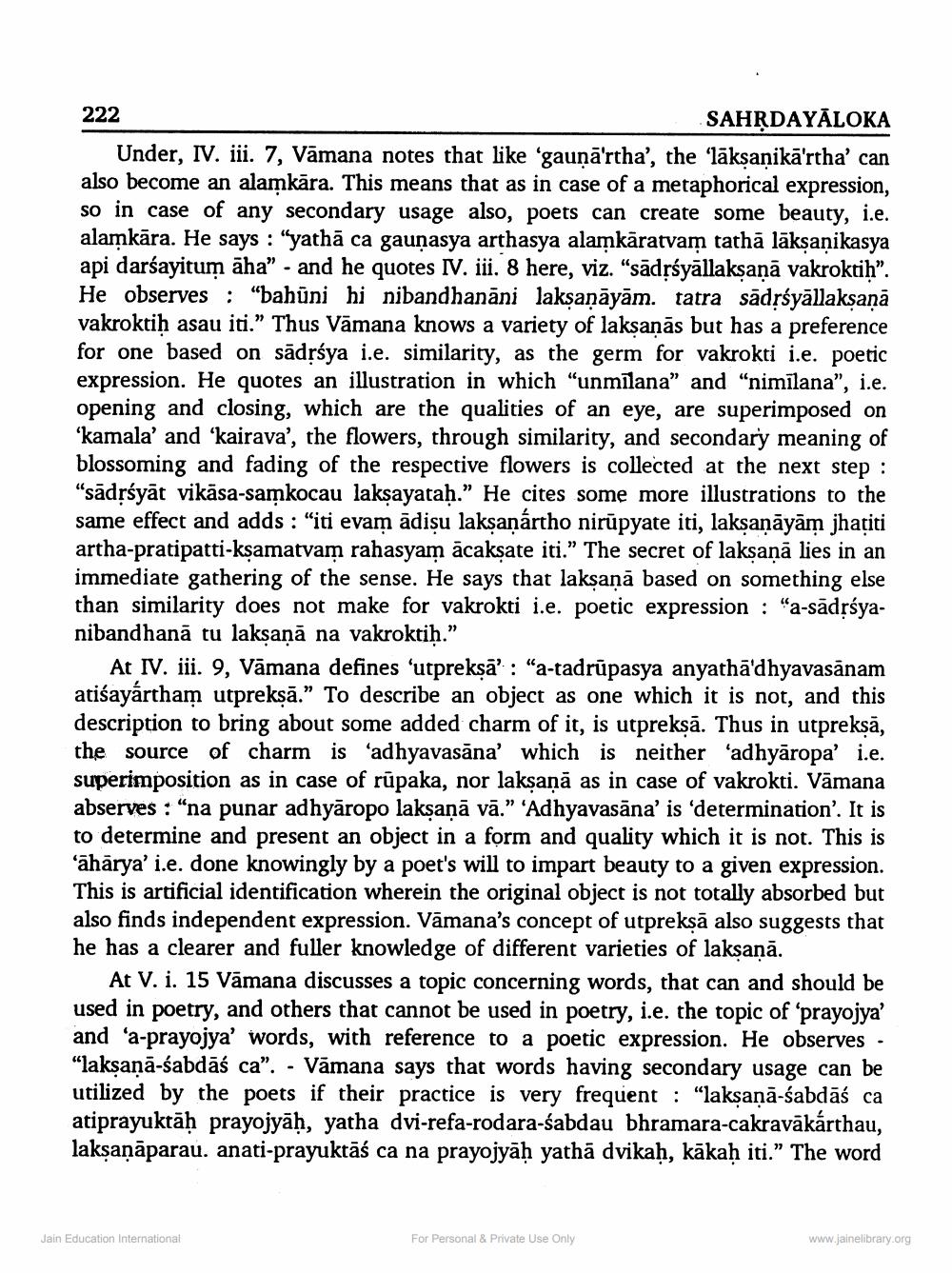________________
222
SAHRDAYĀLOKA Under, IV. iii. 7, Vāmana notes that like 'gaunā'rtha', the 'laksanikā'rtha' can also become an alamkāra. This means that as in case of a metaphorical expression, so in case of any secondary usage also, poets can create some beauty, i.e. alamkāra. He says : "yathā ca gaunasya arthasya alamkāratvam tathā lākṣaṇikasya api darśayitum āha” - and he quotes 1V. iii. 8 here, viz. “sādņśyāllaksaņā vakroktiḥ”. He observes: “bahūni hi nibandhanāni laksanāyām. tatra sādrśyāllaksanā vakroktih asau iti." Thus Vāmana knows a variety of laksanās but has a preference for one based on sādrśya i.e. similarity, as the germ for vakrokti i.e. poetic expression. He quotes an illustration in which “unmīlana” and “nimīlana”, i.e. opening and closing, which are the qualities of an eye, are superimposed on ‘kamala' and ‘kairava', the flowers, through similarity, and secondary meaning of blossoming and fading of the respective flowers is collected at the next step : "sadrśyāt vikāsa-samkocau laksayatah.” He cites some more illustr same effect and adds : “iti evam ādiņu laksanártho nirūpyate iti, laksaņāyām jhatiti artha-pratipatti-kşamatvam rahasyam acaksate iti.” The secret of laksaņā lies in an immediate gathering of the sense. He says that lakṣaṇā based on something else than similarity does not make for vakrokti i.e. poetic expression : "a-sādrśyanibandhanā tu laksanā na vakroktih.”
At IV. iii. 9, Vāmana defines 'utpreksā' : "a-tadrūpasya anyathā'dhyavasānam atiśayártham utpreksā.” To describe an object as one which it is not, and this description to bring about some added charm of it, is utpreksā. Thus in utpreksā, the source of charm is 'adhyavasana' which is neither 'adhyāropa' i.e superimposition as in case of rūpaka, nor laksanā as in case of vakrokti. Vāmana abserves : "na punar adhyāropo laksaņā vā." 'Adhyavasāna' is determination'. It is to determine and present an object in a form and quality which it is not. This is āhārya' i.e. done knowingly by a poet's will to impart beauty to a given expression. This is artificial identification wherein the original object is not totally absorbed but also finds independent expression. Vāmana's concept of utpreksā also suggests that he has a clearer and fuller knowledge of different varieties of laksanā.
At V. i. 15 Vāmana discusses a topic concerning words, that can and should be used in poetry, and others that cannot be used in poetry, i.e. the topic of 'prayojya' and 'a-prayojya' words, with reference to a poetic expression. He observes - "laksanā-sabdās ca". - Vāmana says that words having secondary usage can be utilized by the poets if their practice is very frequent : "laksaņā-sabdāś ca atiprayuktāḥ prayojyāḥ, yatha dvi-refa-rodara-sabdau bhramara-cakravākárthau, lakṣaṇāparau. anati-prayuktāśca na prayojyāḥ yathā dvikaḥ, kākaḥ iti.” The word
Jain Education International
For Personal & Private Use Only
www.jainelibrary.org




